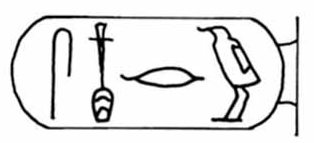Sneferu, ruled 2613-2589 BC
Sneferu was the first king of the Fourth Dynasty
and he was ancient Egypt's greatest pyramid builder and was held in
the highest esteem by later generations. As the son and successor of King Huni and Meresankh I, he was the first
king to use the oval cartouche, as opposed to the rectangular serekh, to frame his name when it was written
down. Sneferu sent out quarrying expeditions to the Sinai turquoise mines at Maghara, and also sent successful
military expeditions against the Libyans and Nubians to secure Egypt's borders. During his reign the final smooth-sided form of the pyramid was perfected, with the king responsible for no
fewer than four such constructions. His first was a step pyramid at Medum, with a much smaller version built at
Seila, near the Fayum. When Sneferu moved his court to Dahshur in his 15th regnal year, work began on a new pyramid at the site. Its
sides at first were very steep, and cracks appeared as the building grew - so its angle of incline was decreased
for the higher sections of the construction. This gave it a strange outline - hence the modern name the Bent
Pyramid. A further pyramid was built for the king at the same site, and this is now known as the Red (or Northern)
Pyramid. This was Egypt's first true pyramid, and the model on which the more famous structures at Giza were
based. It is also thought to be the tomb in which Sneferu was finally buried. Although it is most likely the king's wife, Hetepheres I, was also originally buried at Dahshur, no tomb for
her has been found, and her golden treasures were found at Giza, close to the pyramid of the couple's eldest son
Khufu, who succeeded his father. It is thought the treasures were reburied there after her original tomb was
robbed. Sneferu's other children included Rahotep, High Priest of Heliopolis and commander of the army. Together
with his wife Nofret, he was buried in a large mastaba at Medum, where their superb statues were discovered in
1871. It was during Sneferu's reign that the standard proportions of Egyptian art took shape, and with his
impressive building programme it is not surprising that he was deified during the Middle Kingdom. The king also
appears in a famous Middle Kingdom story, in which he is rowed across a lake by a group of semi-naked women - an
amusing image, but one which may also represent the king as the sun god Ra, being rowed across the heavens by
women displaying the attributes of Ra's daughter, Hathor. Whatever the basis of the story, Sneferu was an inspiration to the later 'sun king' Amenhotep III, who took
an active interest in his ancestor's achievements. Excavations at Dahshur have also revealed that incense was
still being offered to Sneferu's memory 2,000 years after his death. Source: BBC History Sneferu;
https://www.bbc.co.uk/history/historic_figures/snofru.shtml; 05-Jan-2006, 16:42
